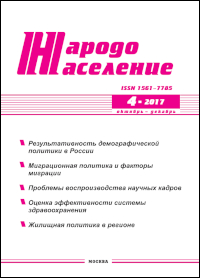Рождаемость населения России и демографические волны
Выражение признательности
Исследование выполнено при финансовой поддержке РГНФ/РФФИпроект № 15-02-00342
Для цитирования
Рыбаковский О. Л., Таюнова О. А. Рождаемость населения России и демографические волны // Народонаселение. 2017. Том 20. № 4. С. 56-66.
Аннотация
В статье раскрывается взаимосвязь между рождаемостью и структурными демографическими волнами в России в XX в. — начале XXI в. Первая мировая и гражданская войны, послевоенный голод 1921-1922 гг. создали первую демографическую яму в динамике рождаемости и структуре населения России. Ровно через поколение эту яму значительно углубили Великая Отечественная война и послевоенный голод 1946-1947 гг. Первым эхом войны было поколение 1965-1971 годов рождения, вторым — поколение 1995-2000 годов рождения, минимальные по численности за весь советский период. Демографическую яму второго эха войны углубили реформы конца XX века, а также два анти-тайминга рождений: свертывание демографической политики 1980-х гг. и откладывание рождений вследствие кризиса 1990-х гг. Напротив, предвоенный подъем рождаемости в России после запрета абортов в 1936 году заложил последующие подъемы рождаемости в конце 1950-х — начале 1960-х гг. и в середине 1980-х годов. Второе эхо этого подъема было стимулировано демографической политикой 1980-х годов. В 2000-х гг. началось третье эхо структурного подъема, когда в наиболее активный детородный возраст стали входить дети 1980-х гг. В этих условиях российское государство активизировало демографическую политику, усилив структурную волну ростом интенсивности рождаемости. Во второй половине 2010-х годов подъем структурной волны прекратился, и демографическая структура начала ухудшаться, что вновь вызвало депопуляцию в России, начиная с 2017 года. Несмотря на это политика в области рождаемости, проводимая в России с 2007 года, возымела положительный эффект. Главное достижение этих лет состоит в том, что прекратилось падение итоговой рождаемости в реальных поколениях женщин. В статье представлены рекомендации по дальнейшей тактике сдерживания ухудшения демографической ситуации.
Ключевые слова:
рождаемость, демографические структурные волны, поколение, демографическая поли-тика, женщины активного детородного возраста, коэффициент суммарной рождаемости
Литература
Андреев Е.М., Дарский Л.Е, Харькова Т. Л. Демографическая история России 1927-1959. — М.: Информатика, 1998.
Рыбаковский Л.Л. Людские потери СССР и России в Великой Отечественной войне. — Изд. 2-е, испр. и доп. — М: Экон-Информ, 2010.
Народное хозяйство СССР за 70 лет. Юбилейный статистический ежегодник. — М.: Финансы и статистика, 1987.
Трегубова Е. Сухой остаток. Как антиалкогольная кампания 80-х повлияла на эко-номику СССР // Вебсайт. Аргументы и факты. 16/05/2014. [Электронный ресурс]. — Режим доступа: http://www.aif.ru/money/economy/1169764
Рыбаковский Л.Л. История и теория миграции населения. Книга первая. Мировые миграции: исторические фрагменты и их детерминанты. — М.: Экон-Информ, 2016
Федеральный закон РФ от 29.12.2006 №256-ФЗ «О дополнительных мерах государственной поддержки семей, имеющих детей».
Рыбаковский Л.Л. Людские потери СССР и России в Великой Отечественной войне. — Изд. 2-е, испр. и доп. — М: Экон-Информ, 2010.
Народное хозяйство СССР за 70 лет. Юбилейный статистический ежегодник. — М.: Финансы и статистика, 1987.
Трегубова Е. Сухой остаток. Как антиалкогольная кампания 80-х повлияла на эко-номику СССР // Вебсайт. Аргументы и факты. 16/05/2014. [Электронный ресурс]. — Режим доступа: http://www.aif.ru/money/economy/1169764
Рыбаковский Л.Л. История и теория миграции населения. Книга первая. Мировые миграции: исторические фрагменты и их детерминанты. — М.: Экон-Информ, 2016
Федеральный закон РФ от 29.12.2006 №256-ФЗ «О дополнительных мерах государственной поддержки семей, имеющих детей».
Форматы цитирования
Другие форматы цитирования:
APA
Рыбаковский, О. Л., & Таюнова, О. А. (2017). Рождаемость населения России и демографические волны. Народонаселение, 20(4), 56-66. извлечено от https://www.jour.fnisc.ru/index.php/population/article/view/6567
Раздел
ДЕМОГРАФИЧЕСКАЯ ПОЛИТИКА И РОЖДАЕМОСТЬ








